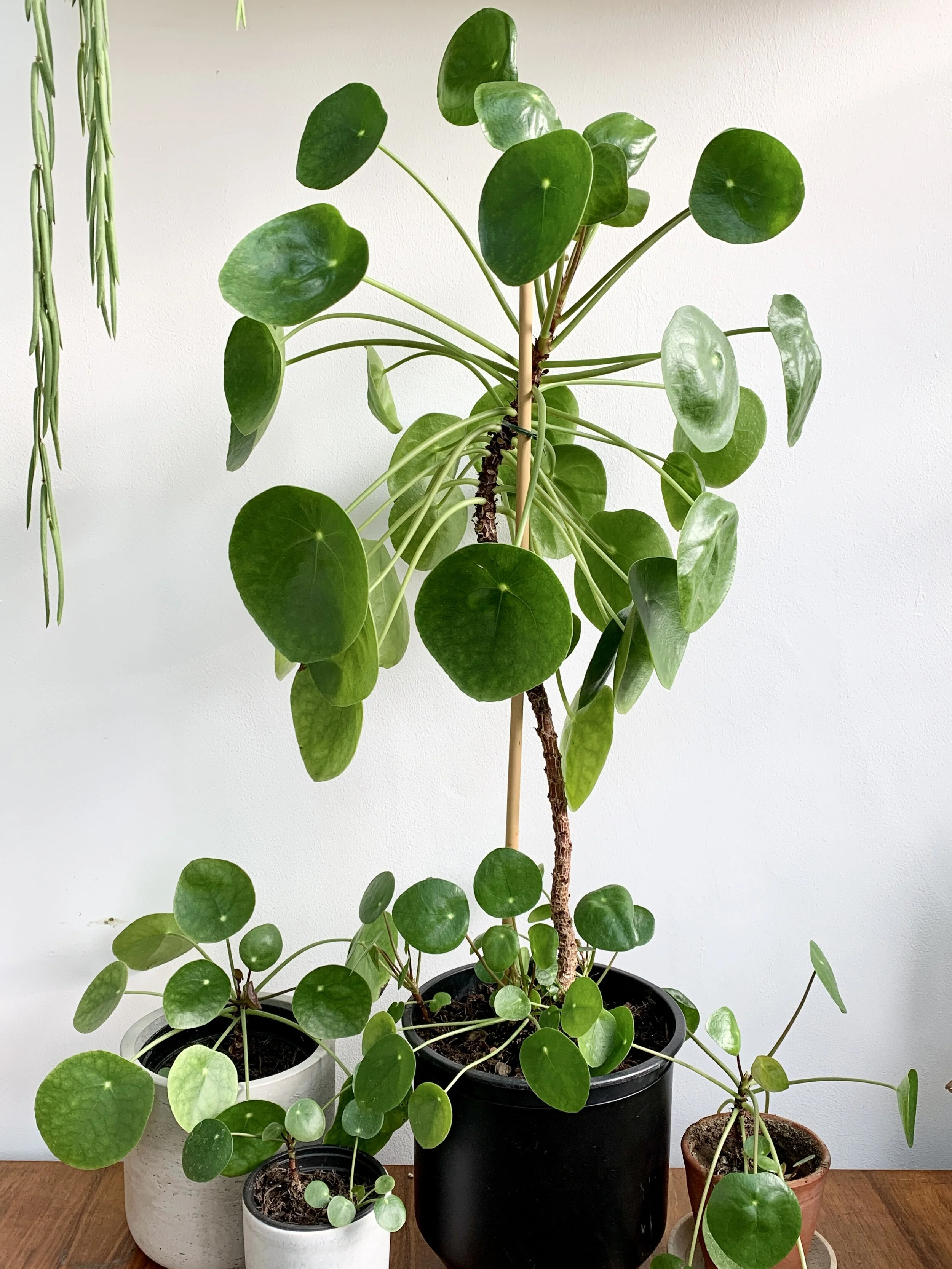One of the more iconic looking houseplants synonymous with the recent resurgence in houseplant popularity is the Chinese Money Plant (Pilea peperomioides).
It is much loved for its almost perfectly round leaves, its speed of growth and its ability to prolifically reproduce, being a great plant to share with friends.
I was given a Pilea peperomioides several years ago when it was only an inch or so tall, it is now over 60cm tall and has produced countless babies that I have given away.
Native Habitat
As its name suggest the Chinese Money Plant is naturally found in Southern China at the foot of the Himalayas where there is a mild climate.
Light
Bright indirect light will be best for this plant. Mine sits about 2m away from a south facing window which I filter with a blind in summer. Close to an east or west facing window will also be a great spot for the Chinese Money Plant. Too much direct sunlight and the leaves will burn, too little light can result in the plant becoming rather straggly with sparse leaves and even turning yellow.
Dark green leaves and not overly-droopy leaf stems are characteristics of a healthy plant.
It is a good idea to regularly rotate your plant so the growth is even on all sides, creating a lovely round-form plant.
As the plant matures and grows new leaves, the older leaves at the bottom will droop more and often turn slightly yellow, this is part of the natural ageing process as the plant puts energy into producing new growth.
In winter the plant will lose its older lower leaves, you can see the difference between summer and winter of my Pilea peperomioides.
Water
The Chinese Money Plant will be happy being slightly dry between waterings, it will not like to be kept damp. This plant is also particularly helpful in telling you when its needs water, its leaves will droop lower than usual and it will look a little sad and wilted. I water mine every 1-2 weeks in summer and every 2-3 weeks in winter. As with many houseplants you can stick your finger into the soil to test if it needs water, if it is dry about an inch or so into the soil it is time to water.
I never water my plants whilst they are sitting within their decorative pots, I always take the plant out of the decorative pot (keeping it in the plastic nursery pot) and water it at the sink. I always make sure the water has fully drained away before placing it back into the decorative pot. Watering your plants whilst they are in their decorative pots may mean they sit in water for too long, which will result in root rot.
It can be common to see small white spots on the underside of Pilea peperomioides leaves, these are not overly concerning, they are mineral deposits and it is the plant simply telling you that it might have had too much water, or too much calcium-rich water. If you live in a hard-water area this is more common and you might find watering with filtered tap water or rain water will stop this. It might also simply be a sign of too much water. Be sure to let the plant dry out a little between waterings.
Humidity
The Chinese Money Plant is not particularly fussy and it can grow happily without the need for increasing the ambient humidity. I have never used any extra methods to increase the humility around my Chinese Money Plant.
However, especially in winter when our houses become dry and are centrally heated many houseplants will benefit from increased humidity, either by using a humidifier, by keeping them in the bathroom if the light is good, or by placing them on pebbles within a tray of water to increase the humidity as the water evaporates.
Soil
A free-draining compost mix is best for this plant. I use 2/3 houseplant compost and 1/3 perlite. The perlite is used to keep the compost draining freely.
Repotting
You can repot your Chinese Money Plant once a year in spring or summer, this will give the plant more room for growth and a boost of nutrients from the new compost. It is best to only increase the pot size by a couple of centimetres. When you repot it is also the perfect time to divide off the several baby plants that are likely to have grown at the base and at the edge of the pot. More on this in the Propagation section below.
Fertiliser
Plants can be fed every 2-3 weeks in spring and summer whilst they are growing the most, there is no need to feed in winter when growth slows or stops completely. We would recommend using Liquid Gold Leaf.
Propagation
Chinese Money Plants are one of the simplest plants to propagate as they grow their own babies at the base of the mother plant. These babies can be easily removed and potted straight into their own pot.
Pilea peperomioides family
Below is a great video giving a step-by-step guide. This video was created for us by plant expert and The Every Space owner Caroline.
Step 1:
Remove the mother plant from its pot, you will see the babies growing at the base towards the edge of the pot.
Step 2:
With a gentle pull and twist action you can easily remove the baby
Step 3:
The baby can be potted straight into its own pot using the potting mix recommended above.
Step 4:
Water the newly potted baby and keep it in a bright spot out of direct sunlight. The soil may dry out more quickly than in a larger pot so be sure to water it when the soil is becoming dry. See the Water section above for when is the right time to water.
It’s that simple!
You can also see a quick reel here of when i repotted and propagated my Pilea peperomioides last summer.
Toxicity
Pilea peperomioides are non-toxic so they are safe to be around pets and children.






